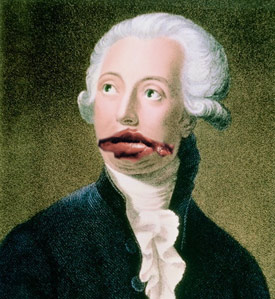Antoine
Laurent Lavoisier
Antoine Laurent Lavoisier was a prominent French aristocrat whose
immense contribution in the areas of chemistry and biology provided
the way to modern chemistry and science. He was the first person
who produced a list of elements found in nature.
|
|
 Antoine Laurent Lavoisier
Antoine Laurent Lavoisier |
Antoine Laurent Lavoisier was the person who founded the major
constituent of our planet and named it as 'Hydrogen' in the year
1783 and acknowledged it was the major component of water. Five
years earlier, he also discovered the most important element of
our earth and named it as 'Oxygen' in the year 1778. In 1777,
he established 'Sulfur' as an element rather than a mixture of
various elements. Because of immense contribution in reforming
the nomenclature system of chemical elements, he is still known
as the 'father of modern chemistry.'
Antoine Laurent Lavoisier was born in a wealthy family of Paris
on August 26, 1743 and he was a student of College Mazarin from
1754 to 1761 where he studied, chemistry, astronomy, mathematics
and botany. At the age of 28, he married Marie-Anne Pierrette
Paulze in the year 1771 when she was just 13 years old. Marie-Anne
also developed interest in chemistry and helped her husband as
a colleague by translating important English documents in French.
She also wrote and published a biography of Antoine Laurent Lavoisier
by the name Lavoisier's memoirs.
Antoine Laurent Lavoisier not only discovered and named Oxygen
he also demonstrated the process of rusting and the importance
of oxygen for the life of animals and plants by establishing role
of Oxygen in respiration. He was one of the first chemists who
performed some completely quantitative chemical experiments to
give birth to stoichiometry. He was the first to establish the
law of conservation of mass. With the help of one of his truly
quantitative chemical experiments, he established that animals
use oxygen as a respiratory gas and the respiratory gas exchange
is a process of combustion that produces heat and is similar to
the process of burning of a candle.
Apart from his role as chemist, botanist and physicist, Antoine
Laurent Lavoisier also achieved a law degree. However, he never
practiced law in his entire life. Being a powerful member of Ferme
Generale, he was one of the 28 tax collectors of France and during
the French revolution he suffered the wrath of French revolutionaries.
While Antoine Laurent Lavoisier was a liberal in the actual sense,
he suffered opposition from Jean-Paul Marat who was a supporter
of revolutionaries.
At the height of French Revolution, Jean-Paul Marat accused Lavoisier
of treachery in selling watered-down tobacco and many other crimes.
In the year 1794, during the period of 'Reign of Terror' Antoine
Laurent Lavoisier helped some foreign born scientists and mathematicians
including Joseph Louis Lagrange and it was considered as treason.
The judge, who was hearing the case of Antoine Laurent Lavoisier,
rejected an appeal to forgive his life to support his incomplete
experiments. The judge claimed, "The Republic needs neither
scientists nor chemists; the course of justice cannot be delayed."
On May 8, 1794, when he was 50 years old, Antoine Laurent Lavoisier
was guillotined in Paris.
Rumor Has It …
Antoine Laurent Lavoisier tried to give hemorrhoids a place on
the elemental periodic table (Hd) but the rest of the scientific
community at that time either sat on their butts or said a few
choice curse words about his outlandish claim.
Written by Kevin Lepton
|

